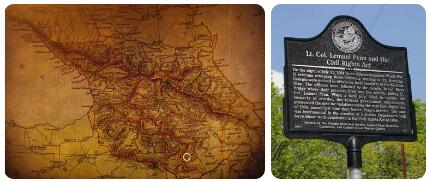Introduction
Georgia (abbr.: GA or Ga.), state of the United States of America, in the east of the country on the Atlantic Ocean, 152,576 km2, with 6.5 million inhabitants; capital: Atlanta.
Physical Geography
Most of the state, about 60%, is taken up by the gently undulating coastal plain or Coastal Plain. In the Fall Line (up to 150 m high), where the rivers have numerous rapids, the coastal plain is sharply demarcated from the Piedmont Plateau, which occupies about 30% of the state’s territory and which in the north (Appalachians ) rises to a height of 450 m. The southward flowing Savannah, border river with South Carolina, is Georgia’s main river. The great lakes are mostly artificial. Okefenokee Swamp (1,690 km2) is one of the largest swamps in the United States. The climate is mild, especially on the coast.
Population
The average population density is 42 inhabitants. per km2. About 63% of the population lives in urban areas. The largest cities are Atlanta, Columbus, Savannah (main port city), Macon and Albany.
Economy
Industry is the most important economic sector, with the textile industry (cotton) in the first place; other important products are transport equipment (including aircraft), foodstuffs (including meat), paper, clothing and chemical products, ship supplies, carpets and various cotton-based products. Trade comes in second place, followed by agriculture. The variety of soil types and the long growing season (180 to 270 days per year) allow for a wide variety of cultivated crops. The main products are cotton, tobacco, grains, nuts and peaches. Also forestry. Livestock farming exceeds arable farming in production value; poultry farming (centre: Gainesville) is especially important.
Sights
Tourist attractions include the 500 m high granite mountain of Stone Mountain, the ancient city of Savannah, Athens, with the University of Georgia (1875), the first state university in the United States, Etowah Mounds Archaeological, an ancient Native American settlement, and the Okefenokee Swamp Nature Reserve.
History
The first Europeans to explore the area were the Spanish explorer Hernan(do) de Soto and his men (1540). In the 17th century, the area was part of the English colony of Carolina; In 1732, the English General James Oglethorpe received a charter from King George II to establish a separate colony in Georgia, named after this monarch. Oglethorpe intended the colony as a refuge for the poor from England and for persecuted Lutherans from Austria. He founded the city of Savannah in 1733, promoted the cultivation of exotic products (including silk) and banned the introduction of slavery. He also made the colony a stronghold against Spanish Florida and defeated the Spaniards at the Battle of Bloody Marsh (1742). In 1752 the administration was transferred directly to the Crown, thus reinforcing the paternalistic character of Oglethorpe’s days. Georgia was the weakest of the thirteen colonies in the American Revolutionary War. It was almost entirely occupied by the English in 1779/1780. Georgia signed the Constitution in 1788. But the boom in cotton farming led to the introduction of slavery and, during the American Civil War, the state ended up in the camp of the southern states, who stood up for their separate rights. The battle with the Cherokee Indians also brought the state into conflict with the federal government, especially when the Supreme Court ruled in favor of Indian rights. However, President Andrew Jackson supported Georgia and the Cherokee were dispossessed and driven to the deserts to the west. In the American Civil War, Georgia was one of the most fervent Southern states, but then it took the idea of separate state law to the point where it came into sharp conflict with the Jefferson Davis administration under its governor Joseph Brown. In 1864, it became the scene of Northern General Sherman’s famous March through Georgia and suffered terrible destruction. It remained one of the most underdeveloped and poorest states in the South, staunchly Democratic in politics and vehemently opposed to black equality. Absolute segregation was implemented about 1900 and a district system gave all power in the state to the county units, the rural districts. After the Second World War, however, a major turnaround was brought about by the rapid growth of industry and major cities. This created a contradiction between the cities and the countryside. Although Coloreds were again elected as delegates to the state congress since 1964, political leadership generally remained in the hands of conservative groups. Reforms were enforced by federal authorities. Race relations improved in the 1980s at the hands of Andrew Young, Atlanta’s second black mayor.
Georgia flag change
In May 2003, the flag of the State of Georgia was changed by an act of the Georgia State Legislature. Per executive order issued by the Bureau of the Governor of Georgia that month, the flag of the State of Georgia was officially changed to the flag at the bottom.
